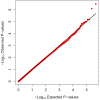Genome wide analysis of drug-induced torsades de pointes: lack of common variants with large effect sizes
- PMID: 24223155
- PMCID: PMC3819377
- DOI: 10.1371/journal.pone.0078511
Genome wide analysis of drug-induced torsades de pointes: lack of common variants with large effect sizes
Abstract
Marked prolongation of the QT interval on the electrocardiogram associated with the polymorphic ventricular tachycardia Torsades de Pointes is a serious adverse event during treatment with antiarrhythmic drugs and other culprit medications, and is a common cause for drug relabeling and withdrawal. Although clinical risk factors have been identified, the syndrome remains unpredictable in an individual patient. Here we used genome-wide association analysis to search for common predisposing genetic variants. Cases of drug-induced Torsades de Pointes (diTdP), treatment tolerant controls, and general population controls were ascertained across multiple sites using common definitions, and genotyped on the Illumina 610k or 1M-Duo BeadChips. Principal Components Analysis was used to select 216 Northwestern European diTdP cases and 771 ancestry-matched controls, including treatment-tolerant and general population subjects. With these sample sizes, there is 80% power to detect a variant at genome-wide significance with minor allele frequency of 10% and conferring an odds ratio of ≥2.7. Tests of association were carried out for each single nucleotide polymorphism (SNP) by logistic regression adjusting for gender and population structure. No SNP reached genome wide-significance; the variant with the lowest P value was rs2276314, a non-synonymous coding variant in C18orf21 (p = 3×10(-7), odds ratio = 2, 95% confidence intervals: 1.5-2.6). The haplotype formed by rs2276314 and a second SNP, rs767531, was significantly more frequent in controls than cases (p = 3×10(-9)). Expanding the number of controls and a gene-based analysis did not yield significant associations. This study argues that common genomic variants do not contribute importantly to risk for drug-induced Torsades de Pointes across multiple drugs.
Conflict of interest statement
Figures





References
-
- Haverkamp W, Breithardt G, Camm AJ, Janse MJ, Rosen MR, et al. (2000) The potential for QT prolongation and proarrhythmia by non- antiarrhythmic drugs: clinical and regulatory implications. Report on a policy conference of the European Society of Cardiology. European Heart Journal 21: 1216–1231. - PubMed
-
- Roden DM (2004) Drug-induced prolongation of the QT Interval. New England Journal of Medicine 350: 1013–1022. - PubMed
-
- The Psychiatrist (2004) DARE: the Drug-Induced Arrhythmia Risk Evaluation Study. The Psychiatrist 28: 431.
Publication types
MeSH terms
Substances
Grants and funding
LinkOut - more resources
Full Text Sources
Other Literature Sources

